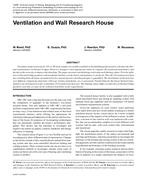Click here to purchase
In building envelope systems, thermal management is important from energy conservation and thermal comfort perspectives, and is typically done via insulation, thermal mass, solar control and shading, etc. Thermal anisotropy is commonly utilized in electronics for heat dissipation. This article investigates the feasibility of utilizing thermally anisotropic composites (TACs) to reduce unwanted heat gains and losses through the building envelope by redirecting the heat transfer to or from appropriate heat sinks and sources. Numerical simulations of building envelope components using finite element analysis (FEA) and whole building simulations using EnergyPlus (E+) were performed to estimate the energy savings potential of TACs used in external walls of residential buildings. Application of TACs was compared with baseline walls with cavity insulation as well as with and without exterior continuous insulation (CI). The (FEA) simulations indicated 75% or higher reductions in heat gains when using a TAC coupled with a heat sink compared to an exterior CI case. In terms of energy savings in a hot climate, E+ models estimated cooling energy savings of 19% with a “TAC + heat sink” compared to a baseline wall with only cavity insulation. Further, a small-scale test sample with a TAC-heat sink system was built and tested in a multi-transducer heat flow meter apparatus (HFMA). The heat sink was a copper tube circulating cold water. The experiments verified the re-direction of heat to a sink and significant reduction in heat transfer through the test specimen. The experiments showed that the heat redirection only occurred in the presence of both thermal anisotropy and water circulation; if either element was missing, the system behaved like a traditional envelope component.
Citation: Thermal Buildings XIV 2019
Product Details
- Published:
- 2019
- Number of Pages:
- 9
- Units of Measure:
- Dual
- File Size:
- 1 file , 1.2 MB
- Product Code(s):
- D-Bldgs19-099


